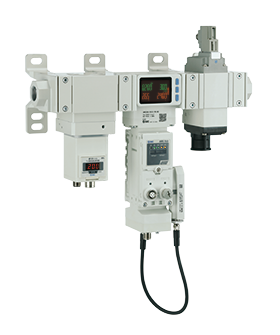

Automation and IIoT specialist SMC is actively addressing the need to reduce CO2 emissions and cut energy consumption with the release of its latest innovation, the AMS20/30/40/60 Series compressed Air Management System. By adopting this revolutionary new air management unit, any company that uses pneumatic processes can achieve reductions of up to 62% in compressed air consumption, benefiting both the environment and bottom line profitability.
Energy waste at manufacturing and process cells is largely attributable to factors that include poor control of air consumption, undetected leaks, and processes which are not optimised for standby and shutdown periods. The consequences include increased, but avoidable, operating costs and breakdown cost effects due to reactive instead of preventive maintenance actions.
Problem-solving technology
SMC’s next-generation AMS20/30/40/60 Series addresses these issues with its combination of regulator, wireless communications hub, and residual pressure relief valve. In addition to monitoring air consumption, which can identify excessive usage and anomalies, those investing in the new air management hub can also monitor the pressure, flow and temperature through the air line, both on a visual display or electronically, to establish baseline ‘ideal’ parameters for cells or individual machines.
The analysis of high-resolution data, collected by the AMS, can establish thresholds for defined preventive actions and maintenance tasks.
This is important as maintenance teams often find it hard to collect specific cell or machine level air-line data, leading to unexpected failures or energy consumption peaks, and only reactive maintenance actions.
Both predictive maintenance and condition-based monitoring strategies can benefit from AMS, as data collection helps to provide a digital fingerprint of preferred or ‘new’ operating conditions, and detect any increasing leak rates. The system also monitors the status of the equipment to analyse variations or spike usage. This subsequently reduces downtime, waste and the need for purely reactive corrective actions.
Higher efficiency, less CO2
Via programmable automatic pressure reduction and shut-off times, AMS permits users to reduce both compressed air and energy consumption, improving process efficiency and reducing CO2 emissions generated in the production of compressed air. Along with improved maintenance capabilities, users also gain from a digitalised ‘connected installation’ for higher levels of control. Dependent on specification, the AMS can also leverage the advantages of innovative and easily scalable, wireless technology, which is easy to integrate to existing PLC systems without communication cables.
Wireless capability is highly beneficial as it both negates the need for complex electrically wired solutions, and the potential for errors with cable connections. Wired systems also add complexity to device configuration tasks and may require an additional PLC or edge server. Communication over long distances can also be slower.
In contrast, the AMS promotes both time and cost savings through economical installation and commissioning, less wiring, and fewer connectors and rotary joints.
The decentralised system is compatible with OPC UA for direct data communication without the need for a PLC. Protocol support includes Ethernet I/P, Profinet and IO-Link . Using a single AMS hub, customers can connect up to 10 additional remote AMS units within a max communication radius of 100 m.
Sustainable solution
The AMS20/30/40/60 Series is therefore a global, sustainable solution that will benefit compressed air users, regardless of whether the application is general manufacturing, automotive, machine tools, electronics, packaging, textiles, food, forestry/paper or life sciences.
The AMS system has an environment protection rating of IP65 or IP67, depending on the type of regulator used.
The AMS consists of three base components:
• Standby E/P regulator - Standby pressure is activated by electrical signal from the Air Management Hub or a Standby mechanical regulator – With manual adjustment to the desired standby pressure.
• Air Management Hub: Measures air flow rate, pressure and temperature, while managing network communication and controlling the configured devices.
• Residual Pressure Relief Valve: Exhausts the downstream pressure based on signal from the AMS Hub.
Working principle
The Air Management System (AMS) functions in three modes: Operation, Standby and Isolation.
When the measured air usage and flow rate is below a settable flow value for longer than a settable time and the external standby input signal is ON
While in Standby Mode and if Auto isolation is enabled, after a second settable time, the Residual Pressure Relief Valve will close and the downstream pressure will be exhausted. In Standby or Isolation Mode, if the Standby input signal switches OFF
If the Standby input signal is ON
Contact SMC Corporation for assistance on your journey to savings and efficient production.


© Technews Publishing (Pty) Ltd | All Rights Reserved